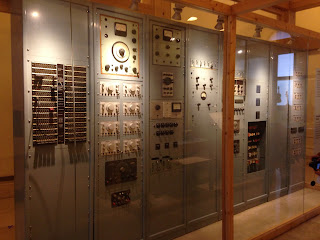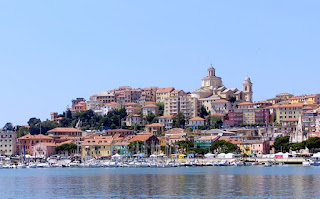War casualty who became significant figure in Italian music
 |
| Luciano Berio was an experimental composer with a prolific output |
The avant-garde composer Luciano Berio, whose substantial
catalogue of diverse work made him one of the most significant figures in music
in Italy in the modern era, was born on this day in 1925 in Oneglia, on the
Ligurian coast.
Noted for his innovative combining of voices and instruments
and his pioneering of electronic music, Berio composed more than 170 pieces between
1937 and his death in 2003.
His most famous works are Sinfonia, a composition for
orchestra and eight voices in five movements commissioned by the New York Philharmonic
Orchestra in 1968, and dedicated to the conductor Leonard Bernstein, and his
Sequenza series of 18 virtuoso solo works that each featured a different
instrument, or in one case a female voice alone.
Berio's musical fascinations included Italian opera,
particularly Monteverdi and Verdi, the 20th-century modernism of Stravinsky,
the Romantic symphonies of Schubert, Brahms and Mahler, folk songs, jazz and
the music of the Beatles.
All these forms influenced him in one way or another and
even his most experimental work paid homage to the past. In writing operas,
concerti, string quartets or pieces for solo instruments, Berio could be said
to have contributed to tradition, even if composing pieces that followed
traditional forms was far from his thinking.
The apparent chaos of Sinfonia, for example, may seem as far
away from a traditional symphony as is possible and yet conforms to the
principle of what constitutes a symphony, a combination of different moods,
keys and emotions.
 |
| Berio at a formal appearance in The Hague in 1972, pictured with Princess Beatrix and Prince Claus of The Netherlands |
The eight voices often speak or shout rather than sing, yet
in superimposing texts by authors ranging from James Joyce to Samuel Beckett
and snatches from many classical and romantic works of music on to a framework
of the scherzo of Mahler's Second Symphony, Berio creates, by definition, a
symphony.
Berio came from a musical background. Both his grandfather
Adolfo and father Ernesto were organists and he might have become a concert
pianist but for the misfortune that befell him in the Second World War.
It was late in the conflict – 1944 – when he was called up.
He considered joining the resistance movement, but feared what the consequences
might be for his family and so accepted conscription. Given a loaded gun on his first day, he was
trying to learn how it worked when it went off, badly injuring his right hand.
He spent three months in a military hospital before fleeing to
Como, joining the partisans after all. When, after the war, he entered the Milan
Conservatory, it was clear his hand injury would prevent him achieving
proficiency as a pianist, at which point he decided to concentrate on composition.
A suite for piano he had written in 1947 was his first work
to be publicly performed. He earned his keep by accompanying singing classes
and accepting conducting engagements in small opera houses.
 |
| The Studio Fonologia in Milan that Berio helped establish |
One of the singers he accompanied was Cathy Berberian, an
American soprano with whom he fell in love and married within a few months. He visited
the United States for the first time on honeymoon and thereafter became a
frequent visitor, where he won a scholarship to study at Tanglewood in Massachusetts,
the summer home of the Boston Philharmonic.
At the same time, Berio was beginning to experiment with
electronic music. He and Bruno Maderna,
another Italian he had met at an annual summer school on Germany where
avant-garde composers would congregate, became co-directors of an electronic
studio within the Milan studios of the state broadcaster, RAI.
He and Berberian divorced in 1964 but Berio continued to
spend much of his time in New York with his second wife, Susan Oyama, a Japanese
psychology student. He had founded the Juilliard Ensemble while teaching at the
Juilliard School of Music. He resigned from the Juilliard in 1971, divorcing
Oyama in the same year.
He returned to Italy and bought a house to renovate in the
hill town of Radicondoli, near Siena, where he planted vineyards and fruit
trees. He moved into the house in 1975 and was soon married for a third time,
to the Israeli musicologist, Talia Pecker.
Berio, whose other acclaimed works include Opera and Coro,
both composed in the 1970s, La Vera Storia (1981) and Outis (1996), remained an
active composer until his death. He was Distinguished
Composer in Residence at Harvard University until 2000, when he became
president of the Accademia Nazionale di Santa Cecilia in Rome, where he was
living at the time of his death.
 |
| The waterfront at Imperia, looking towards Porto Maurizio |
Travel tip:
Oneglia, where Luciano Berio was born, ceased to exist as a
town in its own right in 1923, when it and its neighbour, Porto Maurizio, were
subsumed into a new city of Imperia, created by Benito Mussolini as part of his
drive to create ideal Fascist cities. Today, Imperia is part industrial port
and part tourist resort. What used to be
Oneglia is at the eastern end of Imperia, around Piazza Dante, which is at the
centre of a long shopping street, Via Aurelia.
| The church of Santi Simone e Guida in the ancient town of Radicondoli |
Travel tip:
Radicondoli, situated about 50km (31 miles) west of Siena,
is a beautiful walled medieval town of Etruscan origins, perched on a hilltop
and offering outstanding views of the surrounding countryside, looking out over
typical rolling Tuscan hills. The town
itself, with quaint cobbled streets, is home to little more than 1,000
inhabitants, with an economy and lifestyle based on farming, and a diet rich in
local produce.



